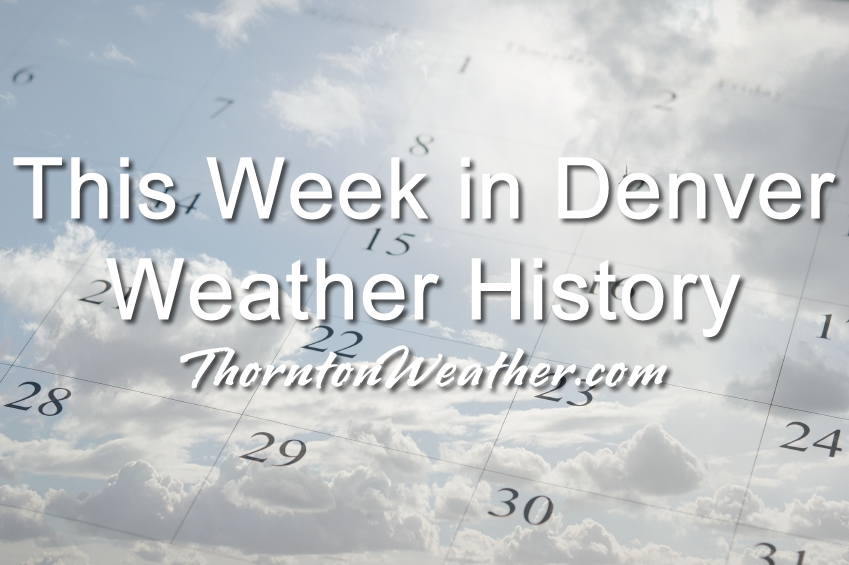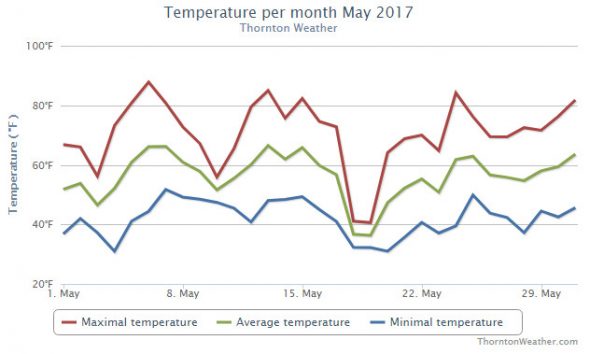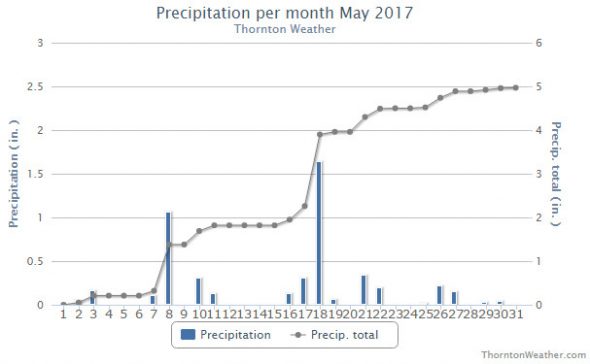
If history is a teacher, our look back at this week in Denver weather history should provide great instruction on the dangers severe weather presents in our history. It was eight years ago this week that the infamous Windsor tornado tore through the area killing one man and damaging hundreds of homes.
From the National Weather Service:
18-20
In 1915…3.9 inches of snow fell in the city. The estimated amount of snow that melted as it fell was 6.2 inches which would have totaled an estimated 10.1 inches of snowfall. Precipitation totaled 1.03 inches. North winds were sustained to 32 mph on the 18th. Low temperatures dipped to 25 degrees on both the 18th and 20th…establishing record minimums for both dates.
In 1988…prolonged heavy rainfall drenched metro Denver. The event began when heavy thunderstorms on the 18th caused some street flooding and power outages…followed by steady rain on the 19th and 20th. Rain amounts across metro Denver totaled 3 to 4 inches. Rainfall totaled 3.71 inches at Stapleton International Airport where north winds gusted to 39 mph on the 20th. Four to eight inches of snow fell in the foothills above 7 thousand feet.
19-20
In 1864…a devastating major flash flood occurred on the normally dry and sandy Cherry Creek in Denver. The flood was caused by heavy thunderstorm rainfall and hail over the palmer ridge to the south of the city in both the Cherry Creek and Plum Creek basins. Nineteen deaths occurred along the South Platte River and Cherry Creek in Denver. The torrent swept cattle and sheep along with large trees and houses before it washing out several bridges…and moving large structures from their foundations. All city records were destroyed when city hall washed away. The Rocky Mountain News building…built on stilts in the middle of the creek…was totally destroyed by the raging waters…which were as deep as 5 feet on the morning of the 20th. Once the flood waters receded…much sand and gravel was left behind. Property damage from the flood was estimated at nearly one million dollars. This was the first major flood of record in the city.
20
In 1874…after a light late afternoon shower…3 rainbows were visible in the eastern sky. The two upper bows were of the usual colors. The lower bow had a deep violet center with a faint yellow and white rim.
In 1892…apparent post-frontal north winds were sustained to 40 mph with gusts to 48 mph. A trace of snow was the last snowfall of the season.
In 1899…snow pellets from 1/4 to 3/8 inch in diameter fell from a thundershower during the late afternoon. West winds were sustained to 42 mph with gusts as high as 48 mph.
In 1904…southeast winds were sustained to 40 mph with an extreme velocity of 42 mph produced by a thunderstorm.
In 1961…a tornado tore through central Douglas County…1 1/2 miles north of Castle Rock. The storm struck 2 ranches and the property of a drilling company. A car on the highway was lifted off the road and slammed into a truck…injuring the two occupants.
In 1983…heavy rain fell in Aurora with 1.00 to 1.50 inches of precipitation. Local flooding occurred in Lakewood.
In 1990…1 inch diameter hail fell at Buckley Field in Aurora. Minor damage was reported to autos…buildings and signs.
In 1995…hail as large as 3/4 inch in diameter fell near Bennett where a funnel cloud was sighted.
In 2001…damaging winds developed behind a vigorous cold front that moved south from Wyoming into metro Denver. High winds…gusting to 58 mph at Denver International Airport…downed trees and power lines and kicked up blowing dust…dirt…and debris…reducing the visibility to near zero at times. The poor visibility caused a multi-vehicle accident along U.S. Highway 85 north of Fort Lupton. Six people were treated for minor injuries. Several vehicles… Including semi-trailers…were blown off I-70 east of Denver. About 32 thousand Xcel energy customers in metro Denver were without electricity for up to 2 hours. At least a dozen incoming flights at Denver International Airport were diverted to other airports. All departing flights were grounded for at least an hour. At southwest plaza…shoppers were evacuated as rocks holding a tarp on a portion of a roof under repair toppled into the mall. After the passage of the cold front…temperatures plunged from the lower 70’s to the mid 30’s in one hour as light snow developed. Heavy snow developed in the foothills during the evening. Peak wind reports included 68 mph near Parker and 63 mph near Sedalia. Snowfall totals included: 7 inches near Blackhawk… At Ken Caryl Ranch…and near Sedalia; 6 inches in Coal Creek Canyon…at Eldorado Springs…and atop Lookout Mountain; 5 inches at Chief Hosa…in Louisville…Rollinsville…and wheat ridge; and 4 inches in Aurora…Bailey…Parker…Castle Rock and near Morrison. Low temperature of 31 degrees during the early morning of the 21st equaled the record low for the date last set in 1931.
In 2004…severe thunderstorms produced hail as large as 1.25 inches near Ft. Lupton and hail to 1.50 inches 10 miles north of Ft. Lupton.
In 2014…severe thunderstorm produced hail… from 1 to 1 1/4 inches in diameter…across parts of Aurora…Denver… Englewood and Lakewood.
20-21
In 1891…heavy rain was mixed with snow at times and totaled 2.02 inches in the city. Snowfall was 1.0 inch. Northeast winds gusted to 28 mph on the 20th.
20-22
In 1959…a three-day rain caused some flooding in metro Denver where rain totaled 1.68 inches at Stapleton Airport. Showers…accompanied by hail near Brighton…caused some damage to truck crops. Heavy snow in the foothills caused damage to power and telephone lines.
20-27
In 2002…lightning sparked a wildfire near Deckers. Extremely dry conditions and very strong winds the following day allowed the fire…known as the Schoonover…to consume 3850 acres before it could be contained. Thirteen structures were destroyed…including 4 homes…resulting in 2.2 million dollars in damage.
21
In 1874…an extensive fire at Central City in the mountains to the west of Denver produced large columns of smoke that were visible from the city. In the afternoon…the smoke and fire produced a dark inky black convective cloud…which spread over the city and produced brief strong and gusty winds along with a few sprinkles of rain.
In 1880…west winds increased to a sustained velocity of 40 mph during the afternoon.
In 1893…north winds were sustained to 48 mph.
In 1914…a severe thunderstorm was attended by hail…excessive rainfall which totaled 1.94 inches…and an unusual amount of vivid lightning. The heavy rainfall of 0.83 inch in 15 minutes produced flooding…which caused considerable damage to bottom lands in eastern and southern parts of the city. Many garden tracts and cellars were flooded. Southwest winds were sustained to 29 mph with gusts to 34 mph.
In 1935…no precipitation occurred…making this one of only two days without precipitation during the entire month. The other day was the 10th. Precipitation totaled 4.95 inches for the month.
In 1952…a tornado produced a high column of dust and dirt over northwest Denver. No damage was reported.
In 1988…a microburst wind gust to 52 mph was recorded at Stapleton International Airport.
In 2002…very strong winds occurred over metro Denver and northeastern Colorado as a developing surface low pressure center intensified. Trees and branches snapped…downing power lines across parts of metro Denver. About 20 thousand residents lost electricity. The strong winds produced much blowing dust and dirt especially to the northeast of metro Denver. Winds gusted to 61 mph at Parker. South winds gusted to 58 mph at Denver International Airport.
In 2006…a large dust devil formed near Quincy Reservoir in south Aurora. The tall column resembling a tornado or smoke plume extended upward into small high-based cumulus clouds and was visible for miles across southern Aurora and eastern centennial. No damage was reported.
In 2014…severe thunderstorms occurred in and around metro Denver. The storms produced large hail…from quarter to golfball size. Frontier Airlines canceled 16 flights…when several planes sustained hail damage. Forty flights at Denver International Airport were either delayed or canceled. Some homes in Green Valley Ranch…east of Denver… were damaged by hail. Several vehicles were also damaged. Five short lived tornadoes touched down near Bennett and Byers but no damage was reported. The storms also produced heavy rain and strong damaging winds. The wind downed trees and power lines east of Denver. The heavy rain and hail…up to 6 inches deep in spots…caused street flooding around the metro area. The hailstorm at Dicks Sporting Goods Park knocked out power to the stadium where the 4A and 5A girls soccer championship games were about to be played. The inclement weather snarled traffic on Interstate 70…Pena Boulevard… U.S. 85 and elsewhere due to the flooded roads. In some areas…snow plows were called out to clear the hail. Parts of Tower Road and Peoria Street…and other roads in Commerce City… were closed through the late evening hours…because of standing water. Several vehicles stalled in standing water where water pooled in the underpasses. At Denver International Airport…1.2 inches of water was observed…along with a wind gust to 42 mph from the northwest.
21-22
In 1878…overnight heavy rains of cloudburst intensity on the Palmer Divide to the south of the city caused flash flooding on Cherry Creek in Denver…which resulted in 2 deaths. A wall of water swept through the city between 2:00 am and 3:00 am on the morning of the 22nd. The flood was so sudden and unexpected that homes along the creek in the city were submerged in water knee deep before the slumbering occupants knew anything about it. By daybreak the banks on both sides of the creek were lined by residents viewing the destruction caused by the raging waters in such a short time. Seven bridges across the creek were destroyed in the city. Damage to private and city property was estimated between 30 and 50 thousand dollars. Quite a number of cattle and sheep were killed along the reach of the creek. Only 0.01 inch of rain fell in the city on the 21st with a trace of rain on the 22nd. Flash flooding also occurred on Kiowa Creek near Bennett on the night of the 21st when the flood waters washed out the Kansas Pacific Railroad bridge. An east bound freight train plunged into the turbulent waters killing the three crewmen. The locomotive was completely buried in the sand and never found to this day!
Continue reading May 20 to May 26: This week in Denver weather history





